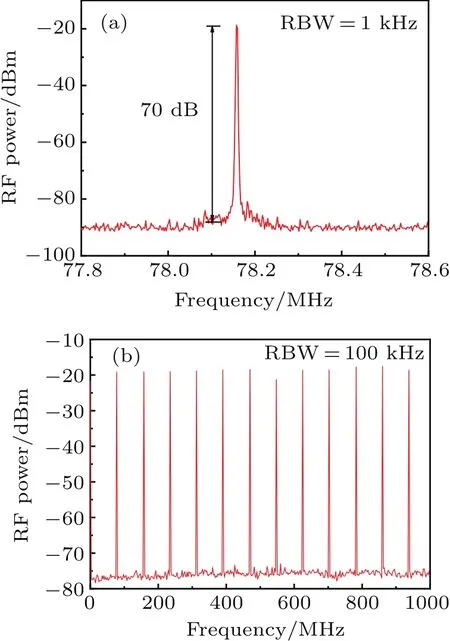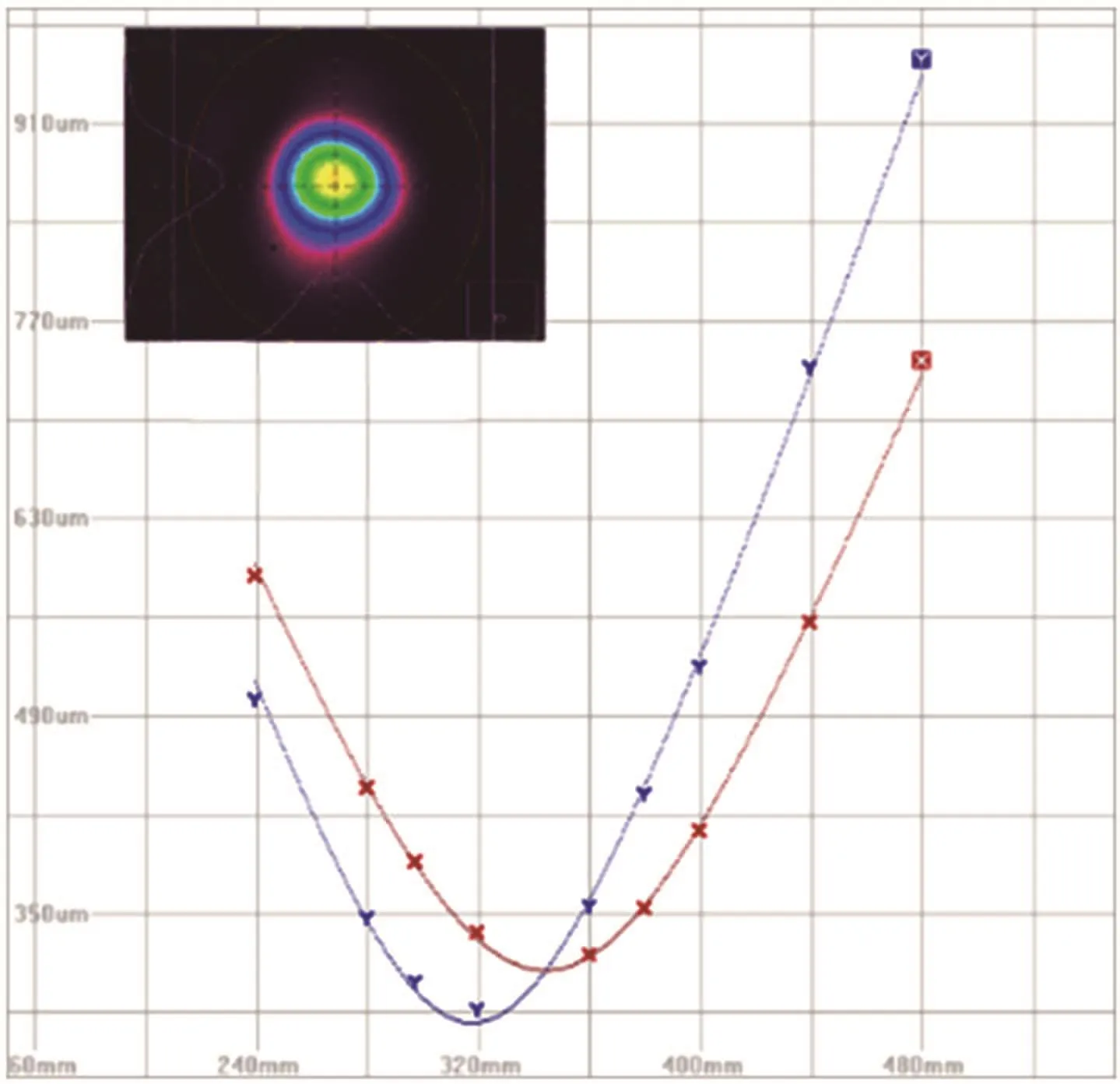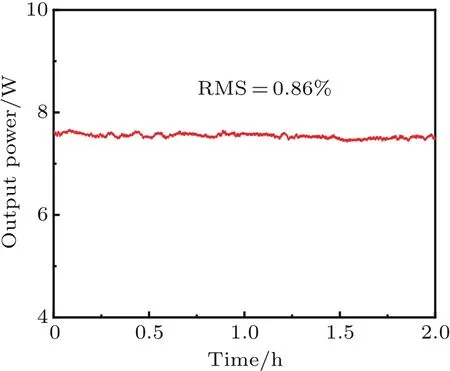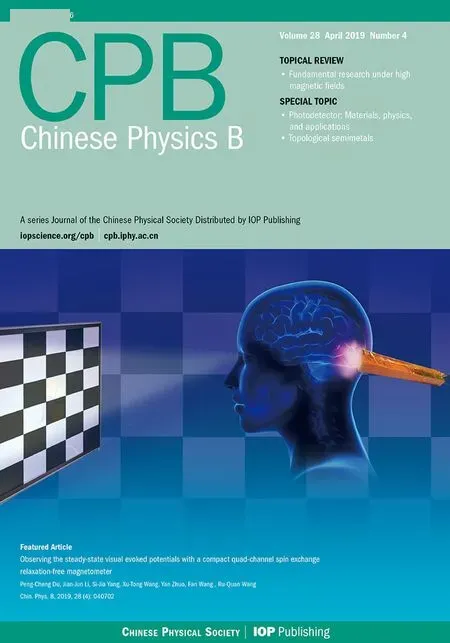7.6-W diode-pumped femtosecond Yb:KGW laser?
Yan-Fang Cao(曹艷芳),Xiang-Hao Meng(孟祥昊),Jun-Li Wang(王軍利),?,Zhao-Hua Wang(王兆華),?,Meng-Yao Cheng(程夢(mèng)堯),Jiang-Feng Zhu(朱江峰),and Zhi-Yi Wei(魏志義),3,4
1School of Physics and Optoelectronic Engineering,Xidian University,Xi’an 710071,China
2Beijing National Laboratory for Condensed Matter Physics,Institute of Physics,Chinese Academy of Sciences,Beijing 100190,China
3University of Chinese Academy of Sciences,Beijing 100049,China
4Songshan Lake Materials Laboratory,Dongguan 523808,China
1.Introduction
Diode-pumped solid-state laser systems with ultrashort pulse duration are of great applications in the fields of industrial,[1]medical,[2,3]and scientific researches.[4,5]Lasers delivered directly from the oscillator with both femtosecond pulse and high output average power are more desirable for many applications.Yb-doped gain media such as Yb:KGd(WO4)2(Yb:KGW),[6–8]Yb:CaYAlO4(Yb:CYA),[9]Yb:CaGdAlO4(Yb:CALGO),[10]Yb:Lu2O3,[11]and Yb:CaF2[12]have been used to generate watt-level femtosecond laser pulses.The highest average output power of 12.5 W was obtained from an 80-MHz Yb:CALGO oscillator with the pulse duration of 94 fs.[10]In 2013,Machinet et al.demonstrated a Kerr-lens mode-locked Yb:CaF2oscillator pumped by a 7-W fiber laser.[12]Due to the high-brightness of the fiber laser,as short as 68 fs pulses with 2.3-W average power were obtained.The mode-locked laser performance is mainly owing to the excellent optical properties of the Yb-doped gain media,including the broad gain bandwidths and the absorption properties that can be pumped by commercially available high-power laser diodes.Compared to the single-mode fiber laser used as a pump source,laser diodes(LDs)have higher power and can be obtained at a lower price,which make the diode-pumped solid-state lasers more suitable for these high-power applications.Among these Yb-doped crystals,Yb:KGW crystals exhibit superior properties because they have broad gain bandwidths(~20 nm),high-emission crosssections(~ 2.8×10?20cm2)and high thermal conductivity(~3.3 W/m/K).[13]These are distinct features for constructing high-power femtosecond oscillators.
High-power femtosecond Yb:KGW mode-locking lasers with SESAM have been demonstrated with efficient and reliable laser performance.In 2012,Li et al.realized a passively mode-locked Yb:KGW laser with 5.06-W average output power and a pulse duration of 410 fs.[14]Kisel et al.further reported an efficient and high-power mode-locked Yb:KGW laser which was initiated by an InGaAs-based SESAM in 2015,an average output power of 8.8 W and 162-fs pulses were obtained by using an output coupler with 20%transmittance.[6]Most recently,the average output power as high as 12 W was obtained,while the pulse duration was 400 fs.[15]Besides,multi-watts with sub-100-fs pulses have been reported by the combination of Kerr-lens and saturable absorber(KLAS)mode locking in recent years.[7,16–18]The shortest pulse of 56 fs and 1.95-W average output power were generated from a Yb:KGW bulk oscillator,while the optical to-optical efficiency was only 10.6%.[18]The Kerr-lens effect can induce the fast loss modulation and enables broadening the emission spectrum.However,the laser cavity needs to be precisely adjusted and the thermal lensing effect would strongly affect laser mode at the high-power regime.Furthermore,the laser also relies on SESAM.
In this paper,we report on a pure SESAM mode-locked femtosecond Yb:KGW all-solid-state laser with both short pulse duration and high average power pumped by a fiber coupled diode laser. By optimizing the spot size on the SESAM and the precise intracavity dispersion compensation,the pulses duration as short as 160 fs was achieved with an output power as high as 7.6 W at the pump power of 28.35 W,corresponding to an optical-to-optical efficiency of 28.8%.Operated at 78 MHz,the pulse energy and the peak power were up to 97 nJ and 606 kW,respectively.
2.Experimental setup
Figure 1 shows the schematic experimental setup.A 5-mm-long Yb:KGW crystal with 3%doping level was used as the gain medium.The crystal was antireflection coated and cut along the Ngaxis.The laser pump source was a multimode fiber-coupled diode laser(100-μm core diameter,0.22 NA),which offered a random-polarized laser mode with a maximum pump power of 40 W at 980 nm.An imaging system with a magnification of 1:2 was used to focus the pump laser from the fiber into the Yb:KGW crystal,resulting in a focused pump spot size of 200μm in the crystal.The classical Z-fold cavity was designed to optimize the spatial pattern matching between the pump and oscillator pulses to realize highly efficient pump absorption and femtosecond mode-locking operation.Based on the ABCD matrix,the cavity mode size was designed to be 212μm inside the Yb:KGW crystal,which perfectly matched with the pump beam size.To eliminate the heat accumulation and maintain a stable temperature,the crystal was wrapped with indium foil and placed in contact with a water-cooled copper heat sink,where the temperature is maintained at 18?C.The absorption efficiency for the pump power of the Yb:KGW crystal was measured to be around 60%under the non-lasing conditions,which depending on the pump power.

Fig.1.Schematic diagram of the experimental setup.LD: fiber-coupled diode laser;DM:plane dichroic mirror;M1–M3:concave mirrors;GTI1–GTI4:Gires–Tournois interferometer mirrors;SESAM:semiconductor saturable absorber mirror;OC:output coupler.
The DM was a plane dichroic mirror which coated with high transmission for the pump and high reflection from 1020 nm to 1100 nm.The Yb:KGW crystal was placed between two concave mirrors M1 and M2.The radii of curvature(ROC)of M1 and M2 were 300 mm and 500 mm,respectively.To initiate and stabilize the passively mode-locking pulse train,the concave mirror M3 with ROC of 500 mm was used to focus the laser beam on the SESAM(Batop GmbH).The SESAM with a modulation depth of 2.4%,a relaxation time of 1 ps and a saturation fluence of 70μJ/cm2was mounted on a precise translation stage.The non-saturable losses and the damage threshold of the SESAM are 1.6%and 3 mJ/cm2,respectively.In addition,the SESAM was also placed on a heat sink,which temperature was kept at 18?C to effectively eliminate the heat accumulation and maintain a stable mode-locked state.Four Gires–Tournois interferometer mirrors(GTI1–GTI4)were used for dispersion compensation in the cavity.The output coupler with 10%transmittance was used to achieve high output power.The total cavity length was about 1.92 m,corresponding to a pulse repetition rate of 78 MHz.
3.Results and discussion
For SESAM mode-locked high-power femtosecond oscillator,the output power of oscillator is limited by the threshold of the SESAM.An effective method to achieve high-power femtosecond pulses is to design a suitable mode size on the SESAM.For too-small mode size on the SESAM would lead to very fast oversaturation and limit the output power,while too-large mode size on the SESAM would hard to achieve stable mode-locking.[19]Therefore,the spot size is 390μm on the surface of SESAM.

Fig.2.Passive mode-locked output power versus the incident pump power.
The oscillator pulses were initially optimized in continuous wave(CW)operation.The pulse delivered a maximum CW output power of 10.34 W with 28.35-W pump power,corresponding to an optical-to-optical efficiency of 36.5%.The output pulses were polarized to the Nmaxis.Four GTI mirrors with a total group velocity dispersion(GVD)of?8000 fs2were introduced to balance the additional chirp due to selfphase modulation and the positive dispersion introduced by the crystal and the cavity mirrors.By carefully aligning the cavity and SESAM,a stable mode-locking laser operation is obtained when the pump increased power up to 14.91 W.The shortest pulse width of 160 fs was achieved with a maximum output power increased up to 7.6 W under the pump power of 28.35 W,corresponding to the optical-to-optical efficiency of 28.8%.Figure 2 shows the mode-locked output power depending on the incident pump power.The mode-locked pulses will become unstable and the SESAM will be damaged when the pump power over to 30.6 W.
The spectrum and the autocorrelation trace of modelocked pulses are shown in Fig.3.The intensity autocorrelation trace was measured by a commercial intensity autocorrelator(Pulse Check,A.P.E.),as shown in Fig.3(a).The pulse duration is 160 fs,assumed a sech2-pulse shape.The mode-locked laser spectrum is shown in Fig.3(b)with a full width at half-maximum(FWHM)of 8 nm,centered at a wavelength of 1048 nm.The corresponding time-bandwidth product is 0.35,close to the Fourier-transform-limited value of 0.315 for the sech2-pulse shape.

Fig.3.Output characteristics of the SESAM mode-locked laser.(a)Measured intensity autocorrelation trace(black solid curve)of the mode-locked pulses with a sech2 fitting(red solid curve).(b)The corresponding spectrum.
The radio frequency(RF)spectrum of the mode-locked pulses was also measured by a commercial RF spectrum analyzer(R&S,FSW26)to claim the states of the mode-locking operation,as shown in Fig.4.The signal-to-noise ratio was 70 dB at the fundamental beat note 78 MHz.No side peaks of the harmonics of the fundamental frequency were observed in the RF spectrum,which means that the oscillator was in a stable mode-locking state.In a wide-range RF scan measurement,as shown in Fig.4(b),no additional peaks between the higher order modes were observed indicating clean mode locking.The beam quality factor M2was measured to be1.118 and 1.123 in the horizontal and vertical directions by a commercial M2factor meter(Spiricon M2-200s),as released in Fig.5.M2X/.M2Y/.

Fig.4.RF spectra of the pulse train.(a)RF spectrum at the fundamental beat note with the resolution bandwidth of 1 kHz.(b)RF spectrum at 1-GHz wide-span with the resolution bandwidth of 100 kHz.

Fig.5.The M2factor and the beam profile(inset)of mode-locked operation.

Fig.6.The power stability of the mode-locked Yb:KGW laser
Power stability of the mode-locked laser was measured by a power meter(LabMax-TOP,Coherent).The root-meansquare(RMS)of power fluctuation is only about 0.86%in 2 hours,shown in Fig.6.The fluctuation of power stability is mainly due to the perturbation of the surrounding environment,such as lab vibration and air turbulence.
The output power of oscillator pulse was limited by the oversaturation of SESAM.In SESAM mode-locked lasers,strong saturation of SESAM can exhibit some additional effects such as two-photon absorption,free-carrier absorption,thermal effects,or various damage.[20]Therefore,high-power SESAM mode-locked oscillators require not only large saturation fluence but also need high damage thresholds and low non-saturable losses.[21]For our experiment,further power scaling can be obtained by reducing the laser power density on the SESAM.
4.Conclusion
In conclusion,we demonstrated an efficient diodepumped high-power femtosecond Yb:KGW laser.By using SESAM mode-locking,the maximum output power is 7.6 W with the shortest pulse duration of 160 fs at the repetition rate of 78 MHz.The pulse energy is 97 nJ and the peak power is up to 606 kW.Further power scaling in our work with SESAM mode-locked Yb:KGW lasers can be obtained by reducing the laser power density on the SESAM and more precise intracavity dispersion compensation.
[1]Ahmmed K M T,Grambow C and Kietzig A M 2014 Micromachines 5 1219
[2]Major A,Barzda V,Piunno P A E,Musikhin S and Krull U J 2005 Proc.SPIE 5969 59690Q
[3]Sibbett W,Lagatsky A A and Brown C T A 2012 Opt.Express 20 6989
[4]Major A,Sandkuijl D and Barzda V 2009 Opt.Express 17 12039
[5]Major A,Cisek R and Barzda V 2006 Proc.SPIE 6108 61080Y
[6]Kisel V E,Rudenkov A S,Pavlyuk A A,Kovalyov A A,Preobrazhenskii V V,Putyato M A,Rubtsova N N,Semyagin B R and Kuleshov N V 2015 Opt.Lett.40 2707
[7]Zhao H and Major A 2013 Opt.Express 21 31846
[8]Akbari R and Major A 2017 Appl.Opt.56 8838
[9]Tian W,Peng Y,Zhang Z,Yu Z,Zhu J,Xu X and Wei Z 2018 Photon.Res.6 127
[10]Greborio A,Guandalini A and Aus der Au J 2012 Proc.SPIE 8235 823511
[11]Ishikawa T,Eilanlou A A,Nabekawa Y,Fujihira Y,Imahoko T,Sumiyoshi T,Kannari F,Kuwata-Gonokami M and Midorikawa K 2015 Jpn.J.Appl.Phys.54 072703
[12]Machinet G,Sevillano P,Guichard F,Dubrasquet R,Camy P,Doualan J L,Moncorg′e R,Georges P,Druon F,Descamps D and Cormier E 2013 Opt.Lett.38 4008
[13]Kuleshov N V,Lagatsky A A,Podlipensky A V,Mikhailov V P and Huber G 1997 Opt.Lett.22 1317
[14]Li J F,Lin H,Zhang H Y and Liang X Y 2012 Laser Phys.Lett.9 415
[15]Zhao H,Cisek R and Barzda V 2017 Photonics North,June 6–8,2017,Ottawa,ON,Canada,p.1
[16]Akbari R,Zhao H,Fedorova K A,Rafailov E U and Major A 2016 Opt.Lett.41 3771
[17]Zhao H and Major A 2014 Opt.Express 22 30425
[18]Akbari R,Fedorova K A,Rafailov E U and Major A 2017 Appl.Phys.B 123 123
[19]Li J,Liang X,He J and Lin H 2011 Chin.Opt.Lett.9 071406
[20]Paschotta R and Keller U 2001 Appl.Phys.B 73 653
[21]Saraceno C J,Schriber C,Mangold M,Hoffmann M,Heckl O H,Baer C R E,Gollling M,Südmeyer T and Keller U 2012 IEEE J.Sel.Top.Quantum Electron.18 29
- Chinese Physics B的其它文章
- Effect of carrier mobility on performance of perovskite solar cells?
- Plasma electrolytic liquefaction of sawdust?
- Insight into band alignment of Zn(O,S)/CZTSe solar cell by simulation?
- Effect of terahertz pulse on gene expression in human eye cells?
- Ultraviolet photodetectors based on wide bandgap oxide semiconductor films?
- A primary model of decoherence in neuronal microtubules based on the interaction Hamiltonian between microtubules and plasmon in the neurons

